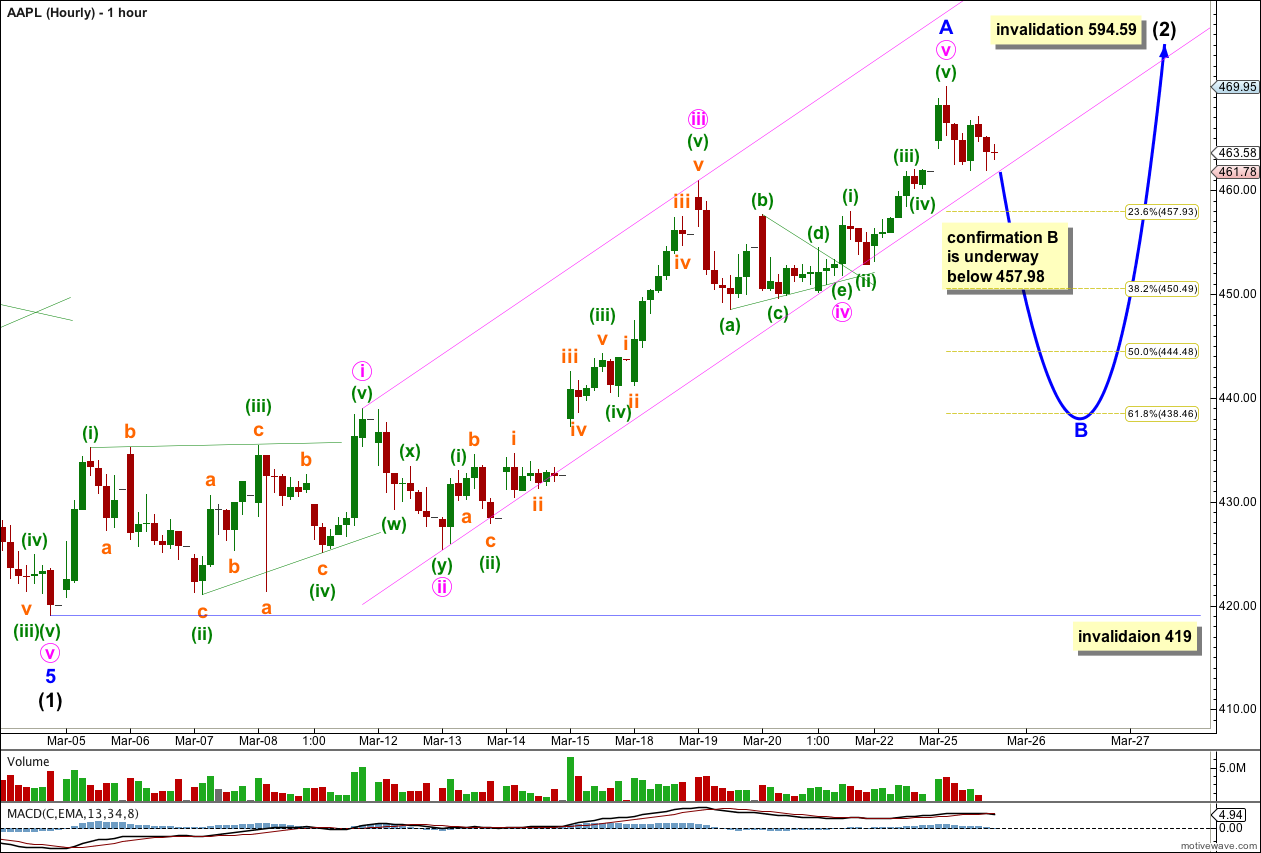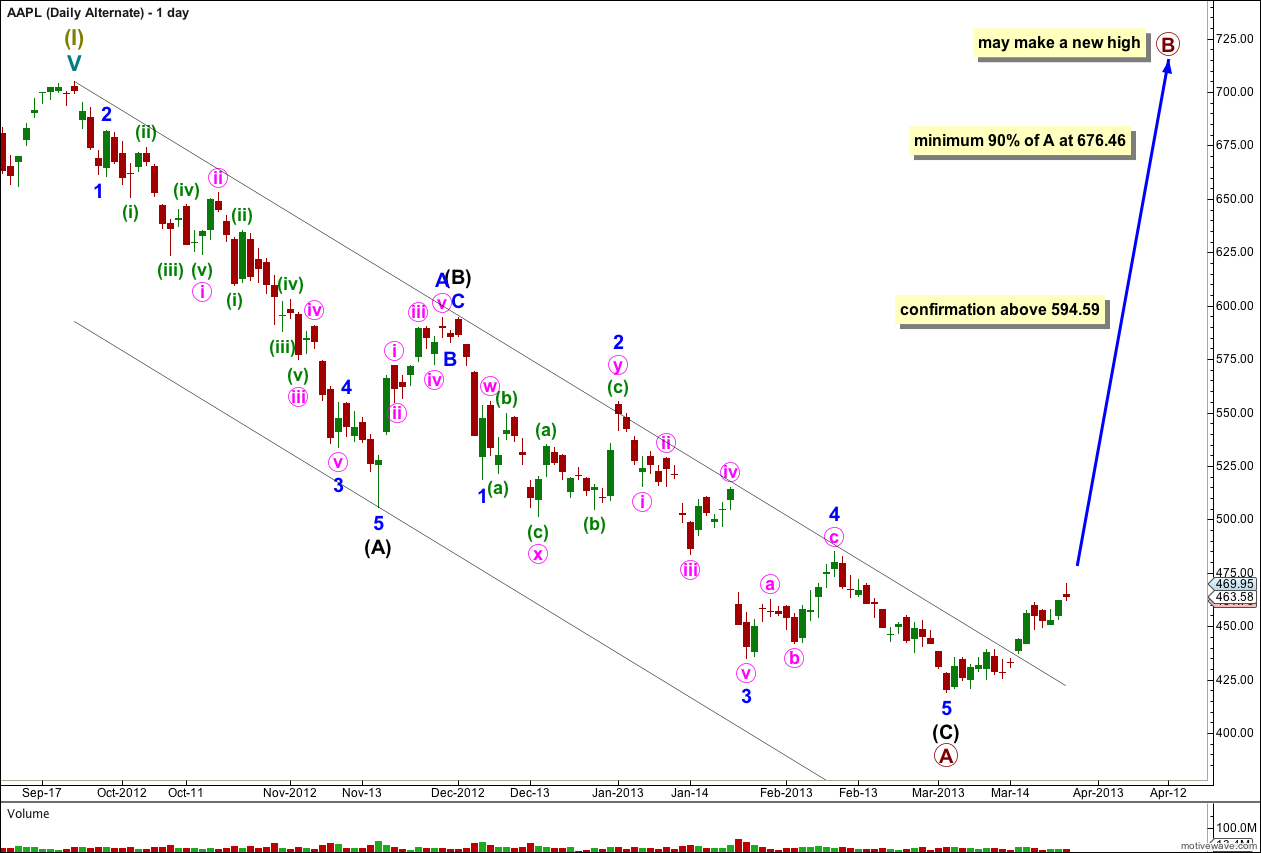Last analysis for AAPL expected price to continue higher to a short term target at 471.82. Upwards movement did continue, reaching up to 469.95 so far, 1.87 short of the target.
This analysis expects to see choppy overlapping generally trending downwards movement for the next few days as minor wave B unfolds.
Click on the charts below to enlarge.
This main wave count expects a five wave impulse for a cycle degree wave a is unfolding to the downside. Within the impulse primary waves 1 and 2 are complete. Primary wave 3 may be extending. Within primary wave 3 intermediate wave (1) is a complete five wave structure and intermediate wave (2) may have just begun.
I would expect at this early stage for intermediate wave (2) to be relatively deep reaching to about 527.51 the 0.618 Fibonacci ratio of intermediate wave (1).
A parallel channel drawn using Elliott’s channeling technique about intermediate wave (1) is clearly breached by upwards movement. This is trend channel confirmation that for now the downwards movement is over and a new upwards trend has begun.
Intermediate wave (2) may not move beyond the start of intermediate wave (1). This main daily wave count is invalidated with movement above 594.59. If price moves above this point then we may use the alternate wave count below.
At 272 primary wave 3 would reach 1.618 the length of primary wave 1. This long term target is months away.
Within intermediate wave (2) minor wave A may now be complete. Minor wave A subdivides best as a five wave impulse so intermediate wave (2) is most likely to be a zigzag.
Ratios within minor wave A are: minute wave iii is 3.23 longer than 1.618 the length of minute wave i, and minute wave v is 1.87 short of equality with minute wave i.
Ratios within minute wave v are: minuette wave (iii) is 0.81 short of 1.618 the length of minuette wave (i), and minuette wave (v) is 0.64 longer than equality with minuette wave (iii).
Within minor wave A minuette wave v lasted a Fiboancci five hours. Within minuette wave v minuette wave (i) lasted a Fibonacci 1 hour, minuette wave (ii) lasted a Fibonacci two hours, minuette wave (iii) lasted a Fibonacci five hours, minuette wave (iv) lasted a Fibonacci two hours, and minuette wave (v) lasted a Fibonacci three hours.
Within the rest of minor wave A I can find no other adequate Fibonacci time relationships.
If minor wave A is over now then we may expect choppy overlapping downwards movement for minor wave B. At this early stage it is impossible to tell what structure may unfold; there are thirteen possible structures. If minor wave B is a flat correction it may make a new price extreme beyond the end of minor wave A so there can be no upper invalidation point for minor wave B at this stage.
When price moves outside of the parallel channel containing minor wave A we shall have trend channel confirmation that minor wave B has begun.
Movement below 457.98 may not be a fourth wave correction within minute wave v of minor wave A, and at that stage minute wave v and minor wave A must be over. At that stage we shall have price confirmation that minor wave B is underway.
Within a zigzag minor wave B may not move beyond the start of minor wave A. This wave count is invalidated with movement below 419.
Alternate Daily Wave Count.
If the main daily wave count is invalidated with upwards movement above 594.59 then this alternate would be confirmed.
If cycle wave a is subdividing into a three wave structure then within it primary wave A may be a complete zigzag. Cycle wave a may be unfolding as a flat correction.
Within primary wave A intermediate waves (A) and (C) have no Fibonacci ratio to each other.
The parallel channel drawn here using Elliott’s technique about a correction is clearly breached by upwards movement. The downwards zigzag is over and an upwards trend has begun.
Primary wave B must subdivide into a three wave structure, most likely a zigzag.
If cycle wave a is a flat correction then primary wave B must reach at least 90% the length of primary wave A at 676.46.
Primary wave B may make a new high above 705.07. Primary wave B should last about six months.



